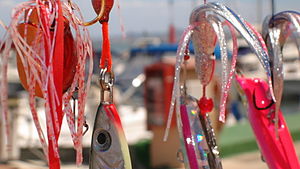This article includes alist of references,related reading,orexternal links,but its sources remain unclear because it lacksinline citations.(April 2009) |
Jiggingis the practice offishingwith ajig,a type of weightedfishing lure.A jig consists of aheavy metal(typicallylead)sinkerwith an attachedfish hookthat is usually obscured inside asoft lureor feather-like decorations. Jigs are intended to create a jerky, vertical "jumping" motion to attract fish, as opposed to other common lures likeswimbaits,spoonsandspinnerbaits,which move through the water more or less horizontally. The jig is very versatile and can be used in both salt and fresh water. Many deeper water fish species are attracted to the lure, which has made it popular among anglers for years.


The jigging technique mainly involves rapid lifting motions of afishing rod,which jerk the line exert a temporarily upward pull upon the sinking lure. When the target fish is enticed to swallow the lure, the angler thensets the hookto pierce and tether the fish in the mouth. Because the jigs are weighted, a harder-than-usual hookset is often needed to overcome the added weight and provide sufficient momentum to pierce the hook point into the fish mouth. Jigging gears are often involved with the luring of slow moving fish, most commonly during spawning periods. For successful jigging, the jigger needs to use a sensitive rod that is good for feeling a strike, and needs to stay in contact with the lure and get it to where the fish are. Most fish caught by jigs are on or near the bottom.
Advantages and disadvantages
editAdvantages of jigging
Jigging is a low-cost, low-energy technique that doesn't necessarily require a bait and its catch can be captured live and hauled into the fishing vessel (boat). Also this method of fishing can be applied locally as well as at commercial (industrial) levels.
Disadvantages of jigging
This technique of fishing is labour intensive and time consuming. Also jigging requires technical knowledge of an area so as to determine when and where it can be used. Furthermore some jigging machines are relatively expensive for the average person to purchase.[1]
Jighead
editThe weighted "head" of a jig, orjighead,can consist of many different shapes and colors along with different features.[2]The simplest and most common is a round head, but others includefish head-shaped, coned-shaped, cylinder-shaped and hybrid varieties that resemblespoonsorspinnerbaits.Most jigheads are integral to a largefish hook,and are most commonly used withsoft plastic baits.
The three most popular jighead shapes inbass fishingare the flipping jighead, the football jighead, and the grass jighead. These come in many different weights usually ranging from1⁄80oz (0.35 g) for small freshwaterpanfishes(e.g.aji) to nearly 1 pound (0.45 kg) for large saltwatergroundfishes,and can also be found in a wide array of colors and patterns. The jig hooks also vary, with variances on the hook type, color, angle or build material. Some jigheads even offer a springlatchknown as aweed guardto prevent unwanted snagging onaquatic plants/weedsandunderwater structuresby the hook point.
Jig body
editThere is a wide array of bodies for jigs. The most common is made out ofrubberorsilicone.These come in many shapes and can resemble a grub, frog, fish, paddle tail, lizard, or different insects. The colors of these can range from bright yellow to a transparent brown with silver and red flakes. Also, during summer months look at colors for the heat such as browns, or blue with black hair. Many others catch fish like smallmouth bass and largemouth bass. Bait such as minnows, leeches or night crawlers can also be used as jig bodies.
Other, more traditional types use dyed or natural whitetail deer tail hair on the outside. Called a bucktail jig, they are widely used in the northern and midwestern United States, where many are still hand tied by anglers.
Other types of materials are also used in constructing jig bodies, such as aChenillewrap on the hook shaft, various feather hackle, hairs or other fur, marabou, Flashabou, and other materials. Construction is often similar to the process ofFly tying.Some jigs are constructed identically to their artificial fly counterparts, one example a "Wooly Bugger"fly but tied on a jig head.
Bodies can be either brightly colored or subdued. They are often designed to mimic localprey fishor large local insects.
See also
editNotes
edit- ^Ken Schultz (1999)Ken Schultz's Fishing Encyclopedia[ FAO ]Archived2010-01-17 at theWayback MachineWiley.ISBN978-0-02-862057-2
- ^"Fishing Jig Basics".Fish Jig.Retrieved11 November2020.
References
edit- Bjarnason, B A (1992).Handlining and squid jigging.FAOtraining series, No 23.ISBN92-5-103100-2
- Gabriel, Otto; Lange, Klaus; von Brandt, Andres; Dahm, Erdmann and Wendt, Thomas (2005)Fish Catching Methods of the World.Page 178. Blackwell Publishing.ISBN0-85238-280-4
- Gilbert, Daniel L; Adelman, William J and Arnold, John M (1990).Squid as experimental animals.Page 21. Springer.ISBN0-306-43513-6
- Gruenwald, Tom (1999).Salt Water Fishing Tactics.Page 21–23. Creative Publishing.ISBN0-86573-085-7
- Sternberg, Dick {2003}.The Ultimate Guide to Freshwater Fishing.Publishing Solutions, Page 82–84.ISBN0-9725580-0-4
- Sternberg, Dick {2003}.The Ultimate Guide to Freshwater Fishing.Publishing Solutions, Page 258.ISBN0-9725580-0-4
- Oberrecht, Kenn {1982}.Angler's Guide to Jigs and JiggingTulsa, OK: Winchester Press.ISBN0-87691-365-6.
External links
edit- Squid jigArchived2017-07-31 at theWayback MachinebyAustralian Fisheries Management Authority(AFMA)